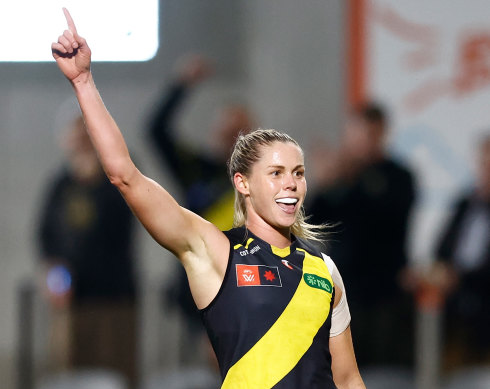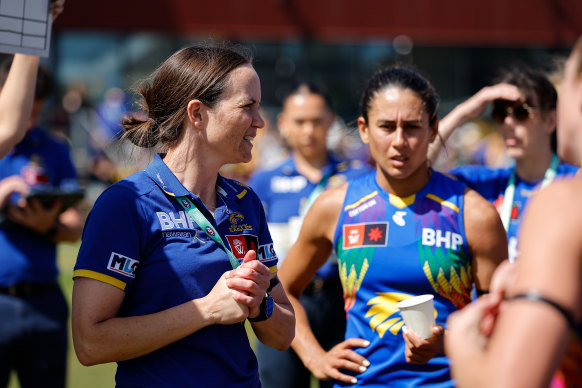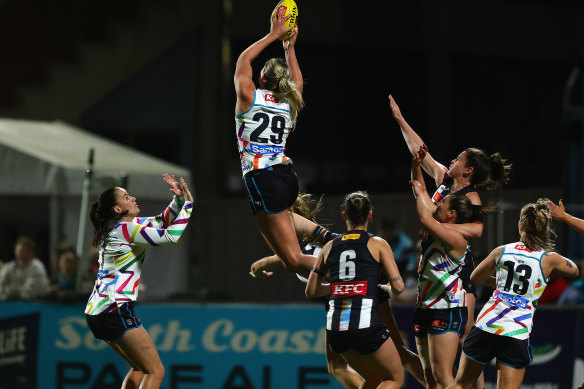This was published 7 months ago
Opinion
How the AFL’s poor decision-making is dragging AFLW down
Peter Ryan
Sports reporterThose in charge of AFLW must act urgently to stop the competition from withering on the vine.
They have failed the participants for too long with poor decision-making, and AFLW players and coaches are frustrated.

Richmond’s Kate Brennan is a star of the competition.Credit: AFL Photos
The AFL doesn’t seem to know what to do except play into the hands of the competition’s critics with marketing gimmicks rather than supporting those involved with a clear vision, belief, investment and certainty.
Club people are concerned about the competition’s direction and the public, except from a cohort of passionate fans, seem disengaged – though it’s hard to know for certain, given the lack of transparency around television ratings.
Big decisions need to be made now and set in stone for a time to allow the game to grow as it should, given the talented female athletes now playing the sport, and those in the pipeline.
Those big decisions include the timing of the season, where and when games are played, and the amount the AFL is prepared to invest to foster coaching and development. Forget the sideshows. Focus on the basics and the rest will follow.
The condensed fixture, which finished on Sunday, is just the latest (and possibly the worst) in a line of knee-jerk decisions that reduce certainty for those playing, coaching and, importantly, watching the game as well as diminishing opportunities for player development – an essential need of a competition that expanded too quickly. The AFL agreed to extend the length of the season by one match for 2024, but was not prepared to start earlier, or push further into cricket season, hence the exhausting fixture crunch.
The impact of the condensed fixture can be reeled off like movie credits and points to administrators taking their eyes off the ball:
- Players unable to train properly between games to work on their own or the team’s performance. There was no time for much-needed match-simulation sessions, and those who weren’t picked were left to train alone. There’s no second-tier comp for them to play in, either.
- Heightened risk of injury, with stars such as North Melbourne captain Emma Kearney now missing after hurting her hamstring during the opening minutes of her third match in nine days.
- Concussion protocols – which require a concussed player to be sidelined for at least 12 days – forcing players to miss up to three matches in an 11-game season.
- Fatigue – both mental and physical.
- Coaches working around the clock to review, edit vision and prepare for the following game in four days, and with little time to work with individuals on their games.
- A low football department cap forcing clubs to appoint part-time assistant coaches who need time off their day jobs to be at mid-week matches and prepare for them. This makes such jobs unappealing.
- Fans forced to follow a schedule with all the rhythm of an uncle on the dance floor at far-flung, second-tier venues that are not conducive to good football, given that the AFL-owned Marvel Stadium, which received funding to improve facilities for women, is not being utilised. Few have been prepared to criticise the AFL publicly but North coach Darren Crocker couldn’t see the logic of staging a Roos home game against Port Adelaide at 5pm on a Friday at Whitten Oval. He wasn’t alone, given 943 people turned up.
- A decline in the standard of umpiring after the men’s season as inexperienced officials adjudicate matches.
We all know the best clubs create an environment for their players to perform in. But the list above works against that objective.
It’s a credit to most of those involved at clubland that the AFLW is improving overall, given the structure in place is working against quality football.
There are blips that justifiably make headlines, such as Friday night’s snooze fest between the Western Bulldogs and the Bombers that was caused by defensive coaching and the impossible task of playing four games in just over a fortnight.
The Western Bulldogs – with due respect – are not the team to be holding a prime-time spot in the schedule, let alone as a curtain raiser for the men’s elimination final, as happened earlier in the season.
The Brisbane Lions, Hawthorn, Geelong, North Melbourne, Melbourne and Sydney play with flair and should be rewarded with prime-time slots that showcase the game’s best.

Despite their defeat to Hawthorn, Daisy Pearce’s West Coast are finally on the right track with their AFLW programCredit: AFL Photos
Their best is miles ahead of any team’s best three years ago, and is a look ahead to what the competition could look like in three years if the right decisions are made.
But the fixture is hopelessly compromised because of the short season, and the Cats sit outside the eight with a percentage of 100.9, jostling for position with Carlton, which has a percentage of 47.5.
Richmond’s Monique Conti, Essendon’s Madison Prespakis and Melbourne’s Kate Hore, as well as excitement machines such as Hawthorn’s Aileen Gilroy, are as good to watch as most AFL players.
The match between Geelong and Hawthorn at GMHBA Stadium on the Thursday night before grand final day was a ripper. The ability to transition the ball and exit stoppage with hands has improved dramatically. Contested marks are no longer a rarity, and goals that would once have been celebrated in the AFLW are now the norm.
But you need to have Herb Elliott’s stamina to have watched the game closely during the condensed period of the season.
There are also many players who need development to master the fundamentals, or show poise when they take possession, or understand the demands of an invasive sport at high intensity. Fast-tracking their progress needs to be high on the list of priorities for the AFL Commission when they review AFLW.

Flying high: Matilda Scholz of Port Adelaide takes a spectacular mark.Credit: AFL Photos
That might require the players to determine whether more games instantly is better, or more training and more development preferable, given the number of teams remains too high for the talent available.
That might mean a reduction in the salary cap to allow more money in the football department cap, so clubs can attract coaches from the Coates Talent League (the boys and girls’ under-18 competition that feeds the drafts). The lifestyle and pay for a Coates Talent League coach is significantly better than it is for an AFLW assistant coach, who needs to work a non-football job while being involved in games played all over the place at variable times and in schedules that are uncertain from year to year. So why would they take a job in an AFLW program?
A refocus may need the players to compromise on their demands for more games, which is possible if the vision is clear – less so right now.
The participants are not fools. Those who care about the game are tapped into what the core product requires to be successful.
Many were left to wonder whether the AFL is as attuned to their needs when the AFLW launch at Melbourne Town Hall in late August heard from everyone but the players, limiting the football focus to a short grab of the excellent documentary featuring the Lions’ flag and announcing Erin Phillips as the premiership cup ambassador.
Entertainers and administrators held the floor when anyone who has dealt with the participants in AFLW knows they are the best asset the game has.
The players are now paid well and the commitment to getting better is there. They are outstanding athletes who work hard and adhere to a strong set of values that has improved the game.
But the structure that surrounds them needs to improve to give everyone involved the best chance to succeed.
AFL fans are not idiots. They know a good game from a not-so-good game and can judge skills and effort, too. No amount of rhetoric or marketing will blind them to what they see with their eyes. They can see the standard of the game is improving when they find the time to watch, but their appetite for the game is not endless.
Most adhere to a football-watching rhythm, with that cycle ending for many on the last Saturday in September. There are only so many football shows, analysis and insight pieces, and matches a family can take before they move into spring. That needs to be recognised when deciding when and where more games of football can find an audience.
The AFL have received their well-deserved pats on the back for getting the competition up and running.
But that time has passed. Now is the time to reflect and consult, and lock in the months the season runs, where and when games will be played, and the amount of investment required to develop AFLW talent.
And tell the participants the plan before this season ends.
They have been stuffed around by poor administration for too long.
The newly appointed head of AFLW Emma Moore has a big job ahead.
Keep up to date with the best AFL coverage in the country. Sign up for the Real Footy newsletter.